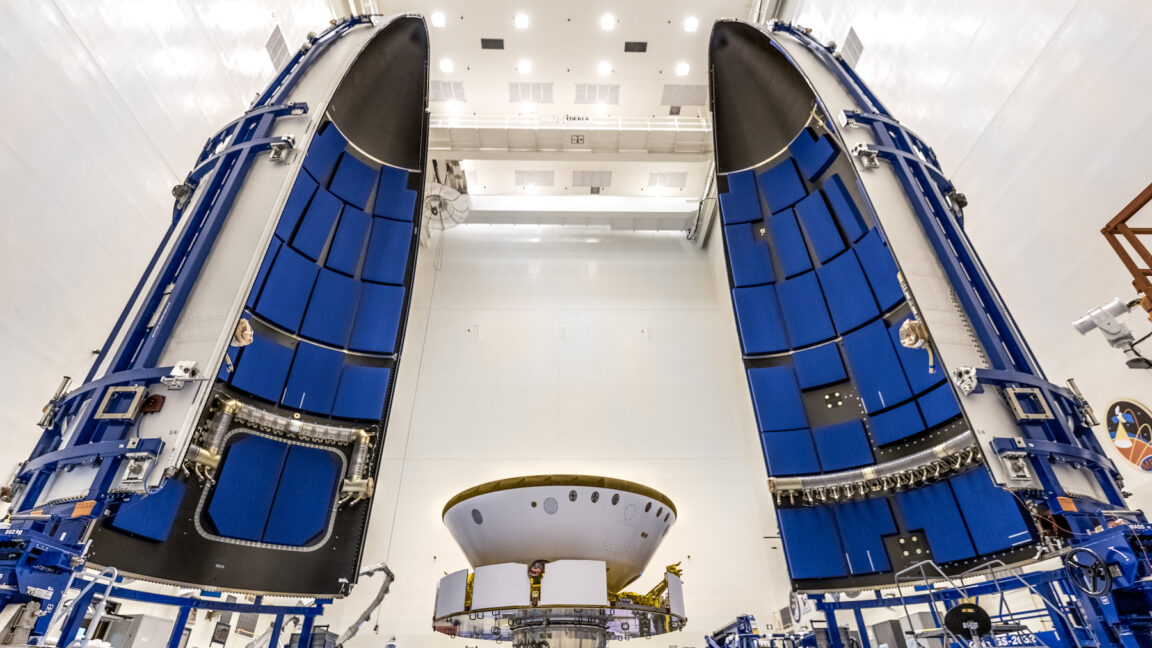A little more than a year ago, a snippet of video that wasn't supposed to go public made its way onto United Launch Alliance's live broadcast of an Atlas V rocket launch carrying three classified surveillance satellites for the US Space Force and the National Reconnaissance Office.
On these types of secretive national security missions, the government typically requests that the launch provider stop providing updates on the ascent into space when the rocket jettisons its two-piece payload fairing a few minutes after launch. And there should be no live video from the rocket released to the public showing the fairing separation sequence, which exposes the payloads to the space environment for the first time.
But the public saw video of the clamshell-like payload fairing falling away from the Atlas V rocket as it fired downrange from Cape Canaveral, Florida, on September 10, 2023. It wasn't pretty. Numerous chunks of material, possibly insulation from the inner wall of the payload shroud's two shells, fell off the fairing. The video embedded below shows the moment of payload fairing jettison.
At this point during a launch, the rocket is usually too far away from the launch site for ground-based observers to get a clear view of how it is performing. The government's idea is to restrict information about the payload's orbital destination, which might reveal something about its purpose, although the efficacy of the policy is questionable due to the proliferation of amateur and commercial groups monitoring space traffic, not to mention the capabilities of foreign adversaries.
The debris from the payload fairing was evident to viewers of ULA's launch broadcast, but more than a year later, the company says it is still investigating the issue.
Payload fairing debris could pose a risk to sensitive components on the spacecraft that the shroud is supposed to protect. The Space Force and NRO have not acknowledged any damage to the three satellites carried on the Atlas V rocket in September 2023.
These three satellites are the first trio of spacecraft for a joint Space Force-NRO program codenamed Silent Barker. The Silent Barker satellites fly in geosynchronous orbit more than 22,000 miles (nearly 36,000 kilometers) over the equator, serving as watchdogs tracking potential threats to multibillion-dollar military and intelligence-gathering satellites.
The NRO broke with its usual policy of not discussing any details of its missions to let adversaries like China and Russia know it has the capability to see what they are doing in orbit.
One source indicated that ULA has observed fairing debris on at least one other classified Atlas V mission, but ULA and the Space Force declared the Silent Barker launch and all other Atlas V flights successful.
Col. James Horne, who oversees launch execution for Space Systems Command, declined to provide more details about the payload fairing issues in a recent interview with Ars. He referred questions on the matter to ULA.
A ULA spokesperson said the company continues to review data related to the fairing debris and will share information upon completion of the investigation.
"We are working very closely with our customers and suppliers on the observations in advance of future launches to improve our capabilities," the spokesperson said. "We have integrated some corrective actions and additional inspections of the hardware."
ULA's new Vulcan rocket, which will replace the Atlas V, has launched on two successful test flights. The company spokesperson said there were no problems with payload fairing debris on either of the two Vulcan flights.
The Vulcan and Atlas V use similar composite payload fairings, both made by Beyond Gravity, the space division of the Swiss company RUAG. The same company also supplies payload fairings for Europe's Ariane 6 and Vega rockets. Beyond Gravity manufactures Atlas V and Vulcan rockets adjacent to ULA's rocket factory in Decatur, Alabama.
"The Vulcan payload fairing is built by the same supplier on both Atlas and Vulcan, and I would say there are substantial differences and substantial similarities between the Vulcan and the Atlas payload fairings, similarities in terms of the manufacturing processes in that they use a low pressure oven... and basically the same type of carbon-fiber layup techniques," Horne said.
ULA now has a second "observation" to investigate as the company prepares to launch the first operational flight of the Vulcan rocket. On the second Vulcan test flight on October 4, the nozzle fell off one of the rocket's strap-on solid-fueled boosters less than 40 seconds after liftoff. The booster kept firing, and Vulcan's main engines compensated for the asymmetrical thrust from the two strap-on motors, allowing the rocket to complete its climb to space and reach its planned trajectory.
Despite the booster nozzle failure, the Vulcan rocket's performance to overcome the problem convinced ULA and Space Force officials that there is no need for another test flight. Space Force officials hope to launch the first national security mission on Vulcan before the end of the year. ULA is already stacking the Vulcan rocket for this launch, although officials have not set a launch date as engineers comb through data on the booster anomaly and ensure the payload fairing is good to go.
While Horne would not discuss the payload fairing debris observations in detail, he said the Space Force could elect to certify the Vulcan rocket for national security launches "with open work as long as we're satisfied that we're on a good path to resolution" of any technical issues.
"In any case, where you may have a crossover between similarities, design, and production, you're always looking to ensure that you don't have a similar sort of issue, even if it's a significantly different mission profile, like Vulcan," Horne said.


